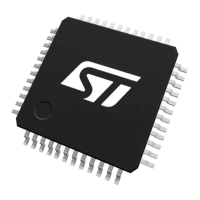RM0444 Rev 5 1003/1390
RM0444 Universal synchonous receiver transmitter (USART)
1138
33.5.2 USART signals
USART bidirectional communications
USART bidirectional communications require a minimum of two pins: Receive Data In (RX)
and Transmit Data Out (TX):
• RX (Receive Data Input)
RX is the serial data input. Oversampling techniques are used for data recovery. They
discriminate between valid incoming data and noise.
• TX (Transmit Data Output)
When the transmitter is disabled, the output pin returns to its I/O port configuration.
When the transmitter is enabled and no data needs to be transmitted, the TX pin is
High. In Single-wire and Smartcard modes, this I/O is used to transmit and receive
data.
RS232 Hardware flow control mode
The following pins are required in RS232 Hardware flow control mode:
• CTS (Clear To Send)
When driven high, this signal blocks the data transmission at the end of the current
transfer.
• RTS (Request To Send)
When it is low, this signal indicates that the USART is ready to receive data.
RS485 Hardware control mode
The following pin is required in RS485 Hardware control mode:
• DE (Driver Enable)
This signal activates the transmission mode of the external transceiver.
Note: DE and RTS share the same pin.
Synchronous master/slave mode and Smartcard mode
The following pin is required in synchronous master/slave mode and Smartcard mode:
• CK
This pin acts as Clock output in Synchronous master and Smartcard modes.
It acts as Clock input is Synchronous slave mode.
In Synchronous Master mode, this pin outputs the transmitter data clock for
synchronous transmission corresponding to SPI master mode (no clock pulses on start
bit and stop bit, and a software option to send a clock pulse on the last data bit). In
parallel, data can be received synchronously on RX pin. This mechanism can be used
to control peripherals featuring shift registers (e.g. LCD drivers). The clock phase and
polarity are software programmable.
In Smartcard mode, CK output provides the clock to the smartcard.
• NSS
This pin acts as Slave Select input in Synchronous slave mode.
Note: NSS and CTS share the same pin.

